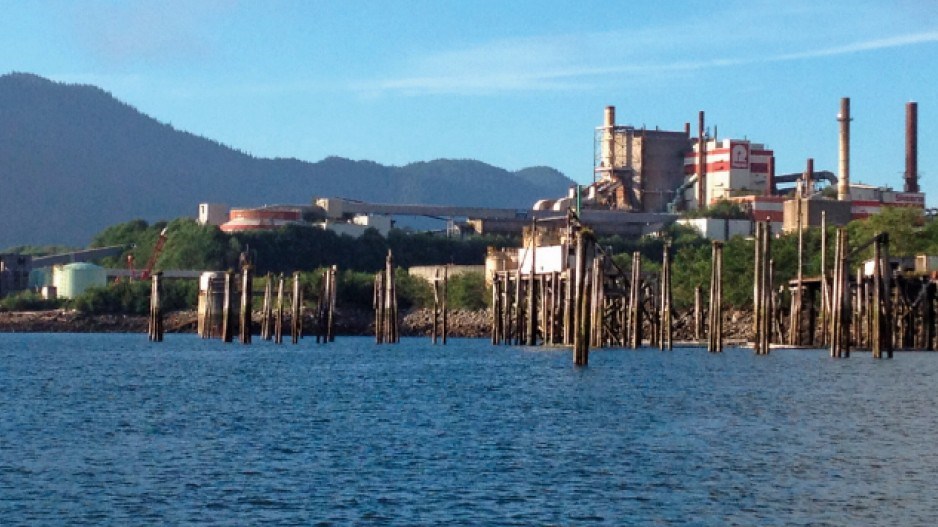The old Skeena Cellulose pulp mill in Prince Rupert, idle since 2001 and subject of a long-running and headline-hitting fight to save it, finally has a potential buyer.
But if the sale is approved – and there are major legal, environmental and regulatory hurdles to clear – the mill would not restart but would be developed into a new bulk shipping terminal and industrial park.
Watson Island Development Corp. (WatCo) is offering the City of Prince Rupert $5 million for the old mill site and $500,000 for contiguous property from the District of Port Edwards.
WatCo is a joint venture involving Colonial Coal International Corp. (TSX-V:CAD), Hillsborough Resources Ltd., and the Lax Kw’alaams and Metlakatla First Nations.
The new terminal would ship metallurgical coal, grain and potash and other commodities, said WatCo CEO Perry Braun.
“We envision 10 to 20 million tonnes of bulk material [per year] going through it eventually,” Braun told Business in Vancouver.
Under an agreement signed with the Kw’alaams and Metlakatla, the two First Nations would own the land and lease it back to WatCo, which would build and operate the Watson Island shipping terminal and industrial park.
Because the mill has no guaranteed fibre supply, Prince Rupert Mayor Jack Mussallem said there’s no chance it will ever reopen, so the city welcomes the WatCo proposal. The city estimates it would create about 200 jobs.
“So you would get the property back on the tax roll, you would get some of the mitigation started on the property and you’d create some jobs out there,” he told Business in Vancouver. “I think it’s a good plan.”
But the consortium must clear several hurdles before it can be sold.The mill, which opened in 1951, was once Prince Rupert’s major employer. It closed in 2001 and was bought in 2006 by Sun Wave Forest, a subsidiary of the China Paper Group, which was forgiven $6.5 million in taxes under the proviso that Sun Wave restart the mill within a year.
But the mill never did restart, and the City of Prince Rupert took possession of the property for unpaid taxes – a move that triggered a legal challenge by the former owner that’s still before the courts.
Another hurdle would be site remediation, which could cost $40 million to $80 million, according to one estimate. WatCo has agreed to cover a portion of the costs for site remediation.
Colonial Coal wants to use the terminal to ship coal from its Huguenot and Flatbed properties in the Tumbler Ridge region, which already has railway connections to Prince Rupert. Colonial is one of several exploration and mining companies that are either already operating or planning to mine coal in the highly productive Tumbler Ridge region. Colonial is projecting to be in production between 2016 and 2018.
Walter Energy (TSX:WLT) and Anglo American PLC are already mining coal in the region.
Teck Resources (TSX:TCK) is planning to reopen its Quintette mine, and Xstrata PLC has been on a recent spending spree, snapping up coal properties in the region.
A new shipping terminal could end up competing with Ridley Terminals Inc. in Prince Rupert, Westshore’s terminals at Roberts Bank and Neptune Terminals in North Vancouver – all of which handle coal.
Ridley Terminals, which declined to comment on the WatCo proposal, has been expanding its coal terminal’s capacity.
Daniel Veniez, a former Ridley Terminals chairman and one-time owner of the doomed Skeena pulp mill, said a new bulk terminal would “definitely be a competitor” with Ridley, at least on the coal side, and he thinks a bulk terminal and industrial park on Watson Island makes good business sense.
Veniez bought the old mill in 2002 but was never able to make the economics work (see timeline).He said shipping berths cost hundreds of millions, so there must to be a proven need for a new terminal to justify the expense.
“It could be a beautiful staging area for a number of businesses along that supply chain,” Veniez said. “If they’re taking a look at it as a long-term real estate play, I think that makes enormous sense for anybody.”
Parker Shectman, an independent consultant, agreed that the Skeena site would be ideal for a terminal, due to its deep water, rail links and proximity to Asia.
“It is the deepest ocean port in the Americas, and it’s a day closer to China than Vancouver,” he said. “Ships are expensive. You shave a day off of that, you just got rid of 20%.”




